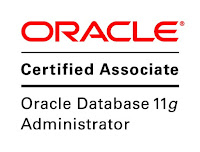A Tablespace is a container for segments (tables, indexes, etc). A database consists of one or more tablespaces, each made up of one or more data files. Tables and indexes are created within a particular tablespace.
When a New database is created, it will have the following tablespaces :
SYSTEM (the data dictionary)
SYSAUX (optional database components)
TEMP (temporary tablespace)
UNDOTBS1 (undo tablespace, contains pre image data)
USERS (default users tablespace created)
Syntax :
Create tablespace
Datafile '/u01/home/prd/cmm.dbf' size 100m
autoextend on
next 100m maxsize unlimited;
Check Free/Used space per tablespace :
SELECT /* + RULE */ df.tablespace_name "Tablespace",
df.bytes / (1024 * 1024) "Size (MB)",
SUM(fs.bytes) / (1024 * 1024) "Free (MB)",
Nvl(Round(SUM(fs.bytes) * 100 / df.bytes),1) "% Free",
Round((df.bytes - SUM(fs.bytes)) * 100 / df.bytes) "% Used"
FROM dba_free_space fs,
(SELECT tablespace_name,SUM(bytes) bytes
FROM dba_data_files
GROUP BY tablespace_name) df
WHERE fs.tablespace_name (+) = df.tablespace_name
GROUP BY df.tablespace_name,df.bytes
UNION ALL
SELECT /* + RULE */ df.tablespace_name tspace,
fs.bytes / (1024 * 1024),
SUM(df.bytes_free) / (1024 * 1024),
Nvl(Round((SUM(fs.bytes) - df.bytes_used) * 100 / fs.bytes), 1),
Round((SUM(fs.bytes) - df.bytes_free) * 100 / fs.bytes)
FROM dba_temp_files fs,
(SELECT tablespace_name,bytes_free,bytes_used
FROM v$temp_space_header
GROUP BY tablespace_name,bytes_free,bytes_used) df
WHERE fs.tablespace_name (+) = df.tablespace_name
GROUP BY df.tablespace_name,fs.bytes,df.bytes_free,df.bytes_used
ORDER BY 4 DESC;
Sample output:
Tablespace Size (MB) Free (MB) % Free % Used
------------------------------ ---------- ---------- ---------- -----------------
UNDOTBS1 65 17.8125 27 73
EXAMPLE 100 22.625 23 75
USERS 5 1.0625 21 79
TEMP 20 2 10 90
SYSAUX 625.125 304.5 48 52
SYSTEM 700 9.0625 1 99
When a New database is created, it will have the following tablespaces :
SYSTEM (the data dictionary)
SYSAUX (optional database components)
TEMP (temporary tablespace)
UNDOTBS1 (undo tablespace, contains pre image data)
USERS (default users tablespace created)
Syntax :
Create tablespace
Datafile '/u01/home/prd/cmm.dbf' size 100m
autoextend on
next 100m maxsize unlimited;
Check Free/Used space per tablespace :
SELECT /* + RULE */ df.tablespace_name "Tablespace",
df.bytes / (1024 * 1024) "Size (MB)",
SUM(fs.bytes) / (1024 * 1024) "Free (MB)",
Nvl(Round(SUM(fs.bytes) * 100 / df.bytes),1) "% Free",
Round((df.bytes - SUM(fs.bytes)) * 100 / df.bytes) "% Used"
FROM dba_free_space fs,
(SELECT tablespace_name,SUM(bytes) bytes
FROM dba_data_files
GROUP BY tablespace_name) df
WHERE fs.tablespace_name (+) = df.tablespace_name
GROUP BY df.tablespace_name,df.bytes
UNION ALL
SELECT /* + RULE */ df.tablespace_name tspace,
fs.bytes / (1024 * 1024),
SUM(df.bytes_free) / (1024 * 1024),
Nvl(Round((SUM(fs.bytes) - df.bytes_used) * 100 / fs.bytes), 1),
Round((SUM(fs.bytes) - df.bytes_free) * 100 / fs.bytes)
FROM dba_temp_files fs,
(SELECT tablespace_name,bytes_free,bytes_used
FROM v$temp_space_header
GROUP BY tablespace_name,bytes_free,bytes_used) df
WHERE fs.tablespace_name (+) = df.tablespace_name
GROUP BY df.tablespace_name,fs.bytes,df.bytes_free,df.bytes_used
ORDER BY 4 DESC;
Sample output:
Tablespace Size (MB) Free (MB) % Free % Used
------------------------------ ---------- ---------- ---------- -----------------
UNDOTBS1 65 17.8125 27 73
EXAMPLE 100 22.625 23 75
USERS 5 1.0625 21 79
TEMP 20 2 10 90
SYSAUX 625.125 304.5 48 52
SYSTEM 700 9.0625 1 99



